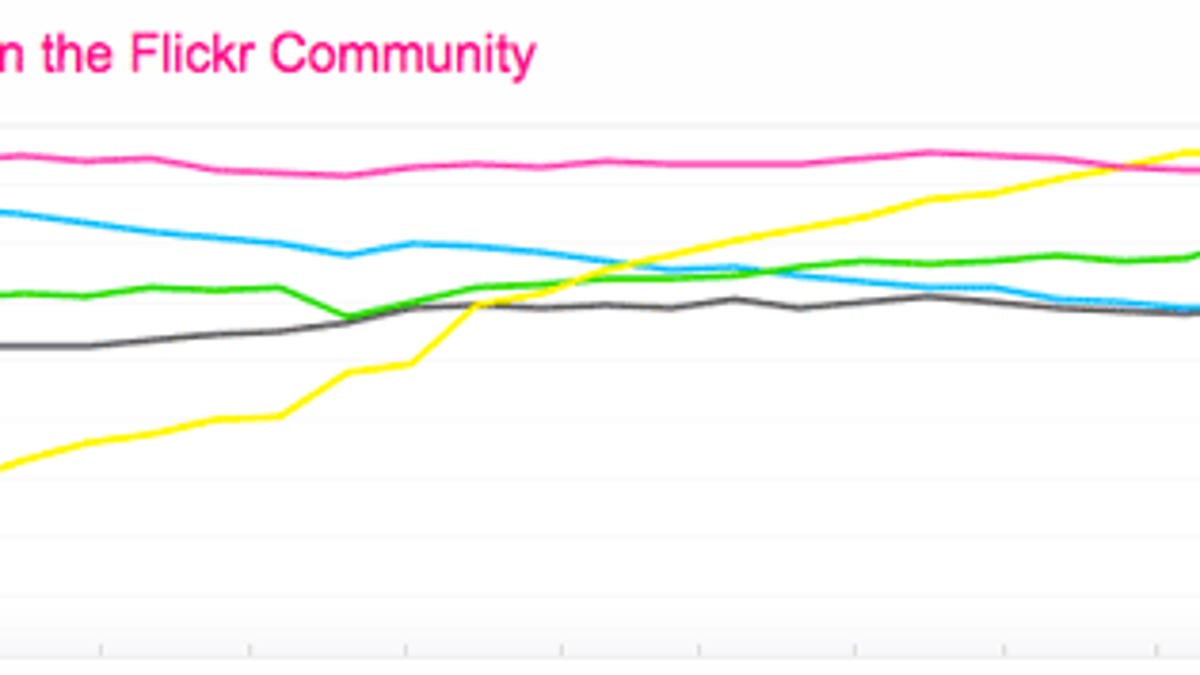iPhone 4 tops Flickr camera stats: A closer look
To nobody's surprise, the iPhone 4 has topped Flickr's popularity charts. The phone fits into people's social lives the way today's ordinary cameras don't.

Less than a year after its debut, Apple's iPhone 4 has topped Flickr's camera popularity charts, nudging Nikon's midrange D90 SLR into the second-place spot.
The achievement, while not a big surprise given the iPhone's steady rise, is notable. Smartphones, not cameras, are becoming the devices that produce the visual record of people's lives.
Point-and-shoot digital cameras have a couple of things going against them. First, people always carry their mobile phones while often leaving the camera behind. That trend accelerates as smartphone cameras' image quality steadily improves--and the iPhone 4's is particularly highly regarded. Dedicated cameras will maintain their image-quality edge and a solid customer base, but increasingly, smartphones are good enough.
Second, it's easy to do something with a photo taken with a smartphone--post it to Facebook, e-mail it to a grandparent, fiddle with it in the Hipstamatic app and publish it on Tumblr, even turn it into a postcard delivered through snail mail. There are a few cameras with network abilities, but it's usually only Wi-Fi, which is far less common than mobile phone data networks.
There's a statistical tidbit worth noting about the stats from Yahoo's photo-sharing site: they reflect daily Flickr usage, not the sheer quantity of photos uploaded. So for the top-level chart, a person who uploads a photo a day will count more than a person who uploads 300 pictures on a single day each month.
That means other measures of popularity can show different results, the total number of photos uploaded with the iPhone 3G, iPhone 3GS, and iPhone 4 is 55.2 million. The Nikon D90's total: 57.9 million.
Another factor: the statistics do a better job spotlighting a given model than a class, category, or product family. Apple sells only a few iPhone models, but Android's market share is spread across hundreds of products. Collectively Android certainly is a force, but it's hard to be sure based on Flickr. The best represented Android phone I could find was HTC's Evo 4G, with just 1.8 million Flickr photos.
The 1001 Noisy Cameras blog argues that the idea of attributing the iPhone's Flickr rise to its network abilities is overdone, instead arguing that it's the result of the sheer number of mobile phones and the likelihood that people have them along.
It's certainly a fair point--millions of iPhones are sold. But overall, I'm inclined to agree with InfoTrends analyst Ed Lee who believes smartphones' network abilities are a severe threat to traditional camera makers.
"Smartphones allow people to capture an image and share it with an online site or a social network. You're allowing your friends and family to be in the moment with you as the event is still going on," Lee said in an interview last year. In other words, the network merges photography into the routine of daily living, and without it, cameras are on the sidelines of life.
That gets to the point that Flickr statistics will never be able to show: the importance to actual humans that a camera carries.
I love landscape and nature photography, and I can spend a long time admiring the technical achievement of a full-page shot of a jewel-bedecked watch, but I have no illusions about what the most important photos are for most folks: the pictures they take of their friends and family, then share with their friends and family. Photography is a form of communication, and smartphones' network connections tap straight into a live communication channel with your closest contacts.

